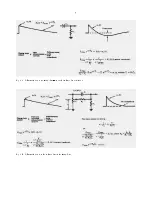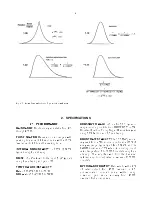
6
3. INSTALLATION
3.1. GENERAL
The 572A operates on power that must be
furnished from a NIM-standard bin and power
supply such as the ORTEC 4001/4002 Series. The
bin and power supply is designed for relay rack
mounting. If the equipment is to be rack mounted,
be sure that thereisadequateventilationto prevent
any localized heating of the components that are
used in the 572A. The temperature of equipment
mounted in racks can easily exceed the maximum
limit of 50
E
C unless precautions are taken.
3.2. CONNECTION TO POWER
The 572A contains no internal power supply and
mustobtainthenecessarydcoperating powerfrom
the bin and power supply in which it is installed for
operation. Always turn off power for the power
supply before inserting or removing any modules.
After all modules have been installed in the bin and
any preamplifiers have also been connected to the
Preamp Power connectors on the amplifiers,check
the dc voltage levels from the power supply to see
that they are not overloaded. The ORTEC
4001/4002 Series Bins and Power Supplies have
convenient test points on the power supply control
panel to permit monitoring these dc levels. If any
one or more of the dc levels indicates an overload,
some of the modules will need to be moved to
another bin to achieve operation.
3.3. CONNECTION TO PREAMPLIFIER
The preamplifier output signal is connected to the
572A through the appropriate Input BNC connector
on the front or rear panel. The input impedance is
about 500Ω and is dc-coupled to ground; therefore
thepreamplifieroutputmustbeeitherac-coupledor
haveapproximatelyzerodcvoltageunderno-signal
conditions.
The 572A incorporates pole-zero cancellation in
order to enhance the overload and count rate
characteristics of the amplifier. This technique
requires matching the network to the preamplifier
decay time constant in order to achieve perfect
compensation.Thepole-zeroadjustmentshouldbe
set each time the preamplifier or the shaping time
constant of the amplifier is changed. For details of
the pole-zero adjustment see Section 4.6. An
alternate method is accomplished easily by using a
monoenergetic source and observing the amplifier
baseline with an oscilloscope after each pulse
under approximately X2 overload conditions.
Adjustment should be made so that the pulse
returns to the baseline in a minimum amount of
time with no undershoot.
Preamplifier power at +24 V, -24 V, +12 V, and
-12 V is available through the Preamp Power
connector on the rear panel. When the preamplifier
is connected, its power requirements are obtained
from the same bin and power supply as is used for
the amplifier, and this increases the dc loading on
each voltage level over and above the
requirements for the 572A at the module position in
the bin.
When the 572A is used with a remotely located
preamplifier (i.e., preamplifier-to-amplifier
connection through 25 ft or more of coaxial cable),
be careful to ensure that the characteristic
impedance of the transmission line from the
preamplifier output to the 572A input is matched.
Since the input impedance of the 572A is about
500Ω, sending-end termination will normally be
preferred; the transmission line should be series-
terminated at the preamplifier output. All ORTEC
preamplifiers contain series terminations that are
either 93Ω or variable; coaxial cable type RG-62/U
or RG-71/U is recommended.
3.4. CONNECTION OF TEST PULSE
GENERATOR
THROUGH A PREAMPLIFIER
The satisfactory
connection of a test pulse generator such as the
ORTEC 419 Precision Pulse Generator or
equivalent depends primarily on two
considerations; the preamplifier must be properly
connected to the 572A as discussed in Section 3.3,
and the proper input signal simulation must be
applied to the preamplifier. To ensure proper input
signal simulation, refer to the instruction manual for
the particular preamplifier being used.
DIRECTLY INTO THE 572A
Since the input of
the 572A has 500Ω of input impedance, the test
pulse generator will normally have to be terminated
at the amplifier input with an additional shunt
resistor. In addition, if the test pulse generator has
a dc offset, a large series isolating capacitor is also
required since the 572A input is dc coupled. The
ORTEC test pulse generators are designed for
Содержание 572A
Страница 6: ...vi...
Страница 24: ...18 Fig 4 16 Gamma Ray Charged Particle Coincidence Experiment Fig 4 17 Gamma Ray Pair Spectrometry...
Страница 26: ...20 Fig 5 1 Amplifier Block Diagram...













































